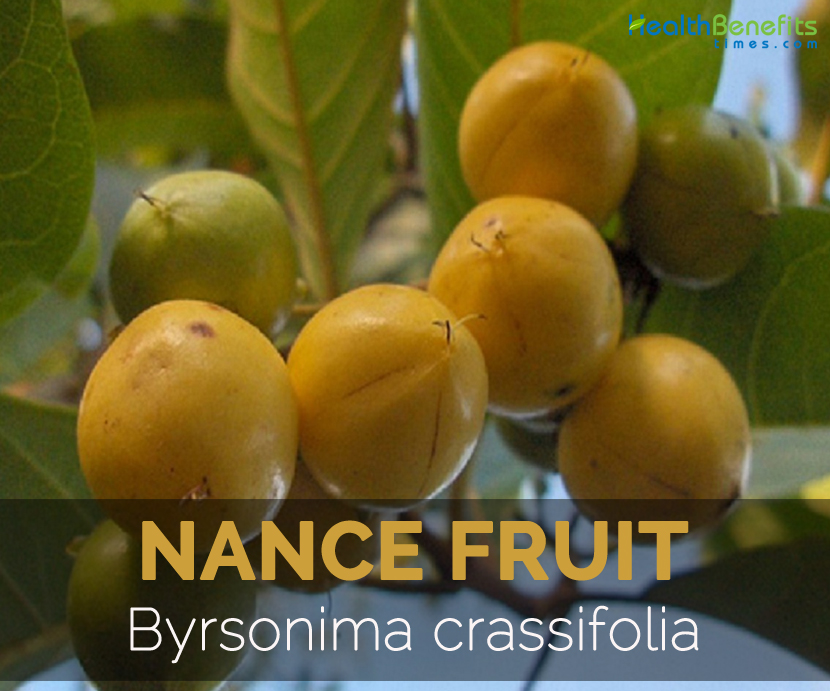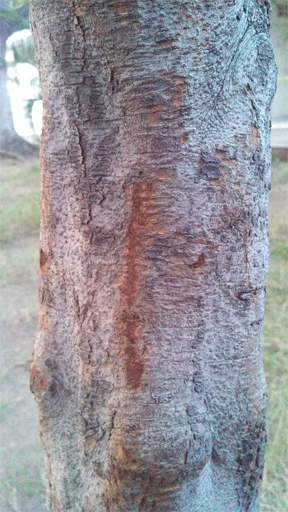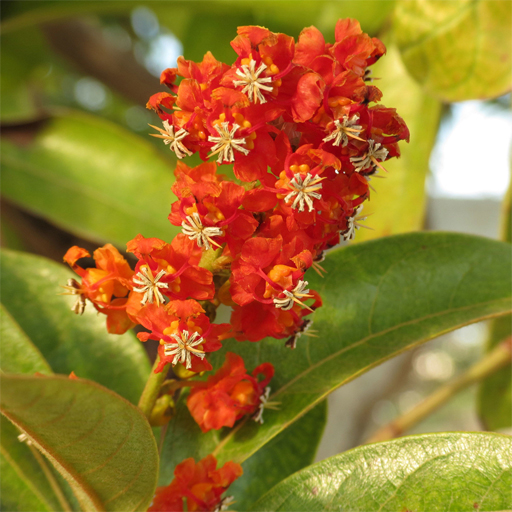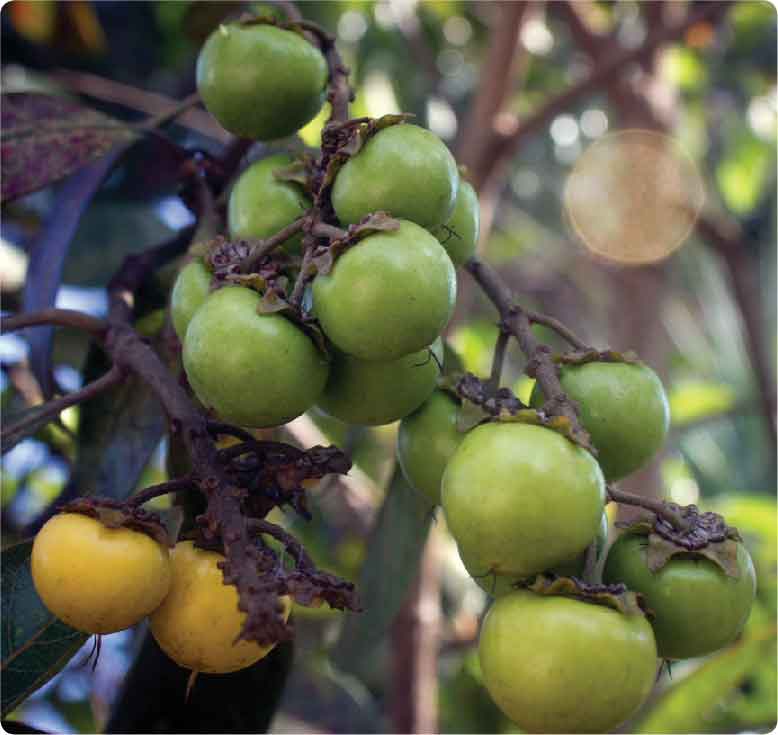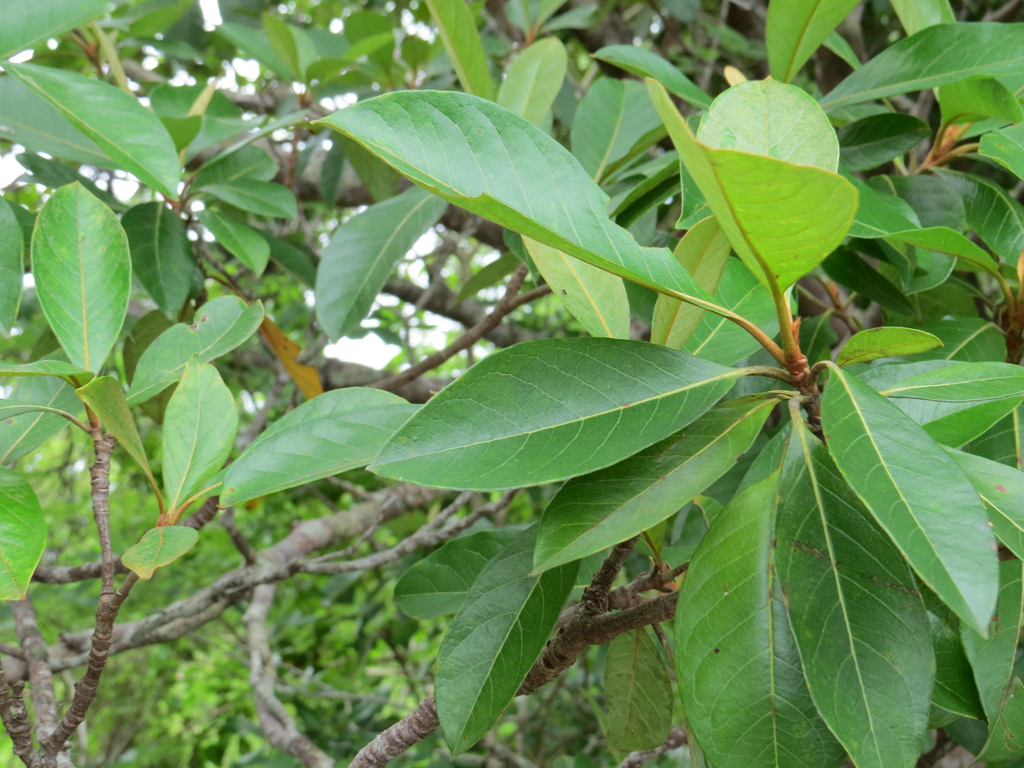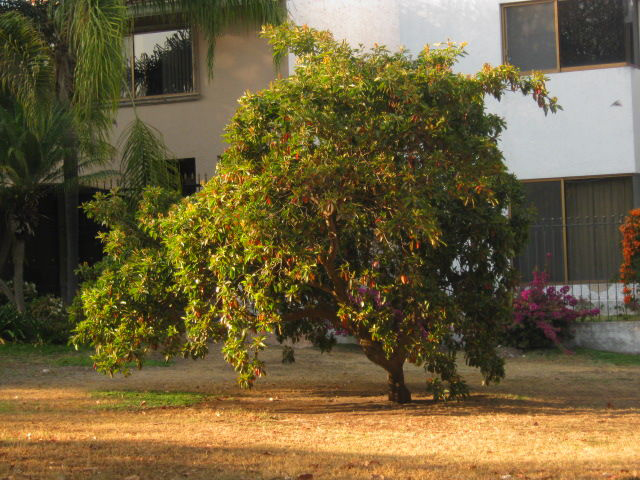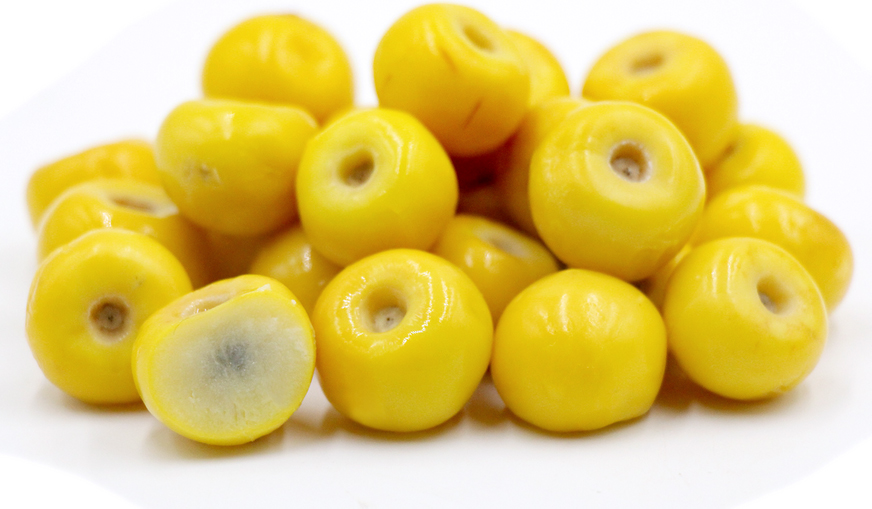| Nance fruit Quick Facts |
| Name: |
Nance fruit |
| Scientific Name: |
Byrsonima crassifolia |
| Origin |
Native to Tropical America |
| Colors |
Orange to yellow (Fruit) |
| Shapes |
Small ball shaped, round, ovate to globose; Width: 8-12 cm; Diameter: 0.8-1.5 cm (Fruit) |
| Flesh colors |
White, juicy |
| Calories |
82 Kcal./cup |
| Major nutrients |
Vitamin C (115.11%)
Total dietary Fiber (22.11%)
Carbohydrate (14.62%)
Manganese (12.09%)
Vitamin K (11.08%)
|
| Health benefits |
Lead toxicity, Treats cancer, Prevent heart problems, Treats diabetes, Reduce sprain and inflammation |
| More facts about Nance fruit |
Nance fruit is a slow growing tree native to the Tropical America. It is primarily cultivated in Peru, Southern Mexico, Pacific side of Central America, Guadeloupe, Barbados, Brazil, St. Martin, Cuba, Haiti, Trinidad, Curacao, Isle of Pines, Puerto Rico, Dominica and The Dominican Republic. It belongs to the acerola family of Malpighiaceae.
It is suitable to the tropical and subtropical climates. The tree bears yellow to dull orange or red flowers during spring to fall and fruits on August and September. The white and juicy flesh of yellow fruit has pungent and distinct flavor. Cao cimun, Golden-spoon, Craboo, Maurissi, Maricao cimun, Murici, Indano, Chaparro, Peraleja, Nance, Changunga, Yoco, Nanche, Muruçi, Kraabu, Chacunga, Savanna serrette are the common names of nance fruit. It attracts butterflies, bees and birds.
Plant
Byrsonima crassifolia is the slow growing, large shrub or tree which grows up to 33 feet high. The leaves are opposite, ovate-elliptic or oblong-elliptic; 3.2-17 cm long and 4-7 cm wide. The flowers are 10-20 cm long and 1.25-2 cm wide; yellow or dull orange, red with five petals. Fruit is small ball shaped, round, ovate to globose; 8-12 cm wide and 0.8-1.5 cm in diameter. The fruit has white and juicy flesh, pungent, distinct aroma and thin skin. The fruit include 1 to 3 white seeds which is 0.5-1.2 cm in diameter. The tree has dark brown, fissured and rough bark. The inner bark is pinkish. It has tall or short and straight or crooked trunk.
Nutritional value
The serving size of 112 grams of Nance fruit grants 90.32 g of water, 82 calories, 0.74 g of protein, 1.3 g of fat, 0.64 g of ash, 19.01 g of carbohydrate, 8.4 g of dietary fiber, 9.31 g of total sugars, 4.01 g of glucose and 5.3 g of fructose. It offers 115.11% of Vitamin C, 12.09% of manganese, 11.08% of Vitamin K, 9.33% of Vitamin E, 5.81% of potassium, 5.38% of iron, 5.24% of magnesium, 5.20% of calcium and 5.11% of copper.
Health Benefits of Nance fruit
The fruits of Nance tree have a single large stone that contains about 2 to 3 seeds. Nance is loaded with minerals and vitamins such as Vitamin K, Vitamin C, thiamine, Vitamin E, riboflavin, pathogenic acid, niacin, folate and manganese. The fruit is an excellent source of soluble dietary fiber, protein, iron, fat, carotene and phosphorus. This provides enormous health benefits to the humans. It helps to prevent from the memory loss, hair fall and wrinkles. It also reduces the risk of dementia and depression. It enhances the formation of antibodies and red blood cells in the body. The leaves are used to make the tea leaves. It possesses antioxidants which help to eliminate the harmful agents as it enhances the immune system. Some health benefits of Nance fruit have been discovered which is discussed below:
- Lead toxicity
The children of urban areas mostly suffer from lead toxicity which is a serious health problem. Those children who are bare to lead have abnormal growth and development. It also leads to the learning disabilities, behavioral problems and low IQ. It may injure the kidneys and raise the blood pressure. The intake of Vitamin C supplements helps to lower the level of blood lead.
- Treats cancer
The high intake of fruits and vegetable are associated with the reduction in the chances of various types of cancer. The studies show that the increase intake of Vitamin C helps to reduce the risk of mouth, lungs, colon, throat, stomach, rectum and esophagus cancer.
- Prevent heart problems
The research shows that there is negative relationship between the intake of insoluble fiber and diastolic and systolic blood pressure, triglycerides and cholesterol level. Additionally, soluble fiber reduces the bad cholesterol by obstructing the dietary cholesterol absorption. The increased intake of diet rich in fiber helps to lower the chances of heart disease, hypertension and metabolic syndrome.
- Treats diabetes
Soluble fiber assists to slow the digestion and stabilize the level of blood sugar. This enhances the sensitivity of insulin and controls the spikes of blood sugar and conditions such as diabetes. The studies show that the dietary fiber and glucose level has inverse relationship so the high fiber helps to prevent the resistance of insulin that is formed due to the elevated level of glucose.
- Reduce sprain and inflammation
Manganese is an aid for inflammation and sprains. It helps to increase the superoxide dismutase level which is due to the antioxidant properties found in this mineral. The arthritis patients have low level of superoxide dismutase (SOD) which possesses anti-inflammatory properties that is required for them. The addition of manganese helps to raise the synthesis and SOD function which also reduces its symptoms. (1)
- Maintains sugar level
Manganese helps to control the sugar level found in the human blood. This helps to prevent the chances of diabetes. Manganese maintains the normal secretion and synthesis of insulin as well as the uncertain drops in the blood sugar could be regulated. This provides the normal life for the diabetic patients. (2)
- Clot blood
Vitamin K helps to clot the blood due to the role in the amalgamation of prothrombium. The blood clot includes the set of molecules which continuously circulates over the bloodstream. Protein Z enhances the thrombin activities in order to enhance the relationship with phospholipids present in the cell membranes. It helps to improve myelodyplastic syndromes.
- Reduce bleeding
Vitamin K helps to lower the liver bleeding, jaundice and absorption of poor nutrient. The problems related with gastrointestinal system due to low presence of Vitamin K are sprue, obstructions, colitis and Crohn’s disease.
- Repair skin
Vitamin E enhances the walls of skin capillaries, elasticity and moisture. It acts as anti-aging nutrients in the body. Vitamin E lowers inflammation in the body, skin by maintaining the youthful skin. The antioxidant properties protect the skin from ultraviolet rays, cigarette smoke and cancer. The intake of Vitamin C with Vitamin E helps to eliminate the skin inflammation and reduces the signs of eczema and acne. It speeds up the healing process and regeneration of cells.
- Assist vision
Vitamin E lowers the chances of age related disease, macular degeneration which could result blindness. Vitamin E is beneficial for the vision. The adequate intake of beta carotene, vitamin C and zinc is essential. The high intake of Vitamin A and Vitamin E helps to enhance the healing and vision in the people who are undergoing the laser eye surgery.
Traditional uses
- The plant helps to cures pulmonary diseases, rashes, wounds and diarrhea.
- The intake of a cup of leaf tea for three times in a day helps to cure the aching bones, anemia, fatigue and rheumatism.
- The bark is used to treat diarrhea.
- This fruit helps to reduce the cholesterol and fats which also prevents from constipation.
- It helps to treat skin wrinkles, hair fall and memory loss.
- The Mixe Indians of Mexico use the bark to cure gastrointestinal disorders and skin infections.
- The infusion made from the bark is useful for diarrhea and enhance menstruation.
- It is effective for the pulmonary complaints, indigestion, leucorrhea and gum disease.
- It is used as an antidote for the snakebite in Belize.
- The bark is used in Guyana as a poultice for wounds.
- Mexicans use the pulverized bark for the ulcers.
- The bark is also used to hide tans, poison fish, treat gastrointestinal, pulmonary diseases as well as skin infections.
- The roots are used as a treatment for illnesses.
- Roots and stems are believed to possess antibacterial properties.
- In Mexico, it is used medicinally to firm up the loose teeth.
- It possesses an antidote, astringent, anti-inflammatory, febrifuge, emmenagogue and purgative activities.
- The external use of bark as a poultice or wash is helpful for skin infections, wounds, ulcers etc.
- The leaves infusion is helpful for the high blood pressure.
- The leaves wash is used to clean and ease ulcers.
- The sap of leaves and bark is used to cure gonorrhea.
- In Central America, the tea made from the leaves is used to eradicate stress, rheumatism, anemia, aching bones and fatigue.
How to Eat
- It is also preserved in a bottle for the future use.
- It is used to prepare carbonated beverages, jellies, jams and also used as meat stuffing.
- Fruits are consumed raw, cooked as dessert and added to soups.
- The fruit is used as an ingredient in sherbets and jellies.
- In Mexico, Nance is cooked with olives and rice.
- In Panama, fruit is used with flour and sugar to make pesada de nance.
- In Brazil and Mexico, Nance is used to make juice and ice cream due to its mild sour and sweet taste.
- In Nicaragua, it is a vital ingredient for the dessert named raspados.
Precautions
- Those who are allergic to Nance fruit should not consume or use it.
- Excessive consumption should be avoided.
References:
http://www.hear.org/pier/species/byrsonima_crassifolia.htm
http://davesgarden.com/guides/pf/go/125410/
https://npgsweb.ars-grin.gov/gringlobal/taxonomydetail.aspx?id=8222
https://www.organicfacts.net/health-benefits/vitamins/health-benefits-of-vitamin-c-or-ascorbic-acid.html
https://draxe.com/high-fiber-diet/
https://www.organicfacts.net/health-benefits/vitamins/health-benefits-of-vitamin-k.html
https://draxe.com/vitamin-e-benefits/
http://www.backyardnature.net/yucatan/nance.htm
http://www.worldagroforestry.org/treedb/AFTPDFS/Byrsonima_crassifolia.PDF
https://hort.purdue.edu/newcrop/morton/nance.html
http://www.fruitsinfo.com/nance-fruit.php
https://en.wikipedia.org/wiki/Byrsonima_crassifolia
Comments
comments


